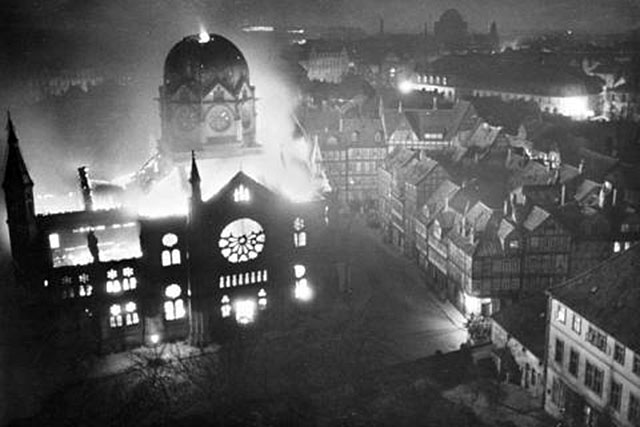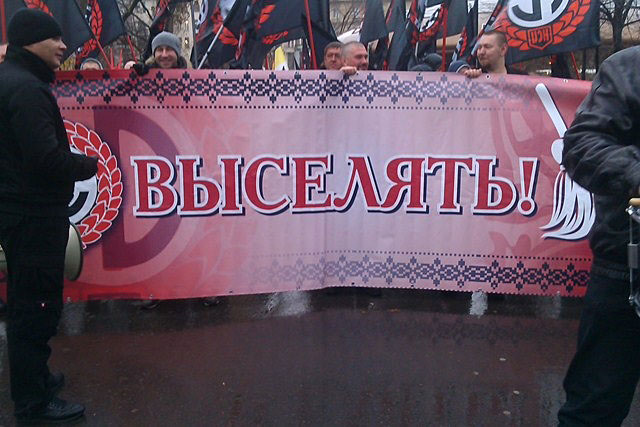November 9 is the International Day against Fascism and Anti-Semitism, an annual commemoration of Kristallnacht. This year marks the 75th anniversary of the anti-Semitic pogroms in Nazi Germany that became the starting point of the Holocaust. IMR Advisor Boris Bruk recalls the events of November 1938, and draws parallels with present-day Russia.

A synagogue burns in Germany. November 1938.
Starting on the night of November 9, 1938, and continuing into the next day, a wave of pogroms against Jews swept across Germany and into Austria. Over the course of these pogroms, at least 91 people were murdered, and hundreds of synagogues and thousands of Jewish enterprises, stores, and houses were destroyed. Some thirty thousand Jews were arrested and sent to concentration camps. The terrible Night of Broken Glass is now understood to be the opening chapter of the Holocaust that took the lives of six million Jews. German Chancellor Angela Merkel has said of the event, “We know the unspeakable began that day and ended with the Holocaust.”
In the early 1930s, the number of Jews residing in Germany was estimated at around 500,000 people (less than 1 percent of the population). Many were fully assimilated and considered themselves Germans. With the spread of the National Socialist ideology and Hitler’s rise to power, the situation changed: racial anti-Semitism now formed the core of the German political agenda. In early April 1933 (two months after Hitler took office), the Nazis organized a boycott of Jewish shops and enterprises, displaying banners that read, “Germans, don’t buy from Jews!” and “Germans, defend yourself against Jewish domination!” In the same month, Jews were no longer allowed to hold positions in civil service and universities. In May of that year, Nazis and their followers burned any books that contained “un-German” ideas.
In 1935, the government passed the so-called Nuremberg Race Laws, which legalized a range of already enforced aspects of the Nazi ideology and heightened discrimination against Jews. Among other things, the Nuremberg Laws deprived Jews of citizenship and prohibited marriage and sexual relations between Jews and other Germans. Additionally, these laws deprived Jews of most political rights. In July 1938, Jews were ordered to carry special identity cards, and in August, all Jews were obligated to add the name Israel (for men) or Sarah (for women) to their existing names, and to use these “Jewish names” in all official documents and correspondence. Anti-Jewish campaigns swamped Germany; many locations bore signs prohibiting access to Jews or expressing that Jews were unwelcome.
For all those years, the Nazi propaganda machine operated tirelessly. Furthermore, as German Jew Victor Klemperer wrote in 1946, “Nazism permeated the flesh and blood of the people through single words, idioms, and sentence structures, which were imposed on them in a million repetitions and taken on board mechanically and unconsciously.” The Germans were fed a steady diet of racial hatred.
In late October 1938, thousands of Polish Jews were expelled from Germany. The Polish government refused to admit the Jews to the country, and, as a result, they were forced to stay in the area of the German-Polish border without any means for living. Among those individuals were the parents and sister of seventeen-year-old Herschel Grynszpan, who resided in Paris at the time. In early November 1938, Herschel received a postcard from his family telling him of the unbearable living conditions in which they were placed and asking him to send money to them. On November 7, 1938, Herschel walked into the German Embassy and told the guard that he wanted to talk about some document with the ambassador. Since the ambassador was not in the office, he was taken to speak with Third Secretary Ernst vom Rath. Herschel pulled out a gun and shot the German diplomat. When he was arrested, he carried in his pocket a message to his parents explaining that he could not have done otherwise: “My heart bleeds at the news of 12,000 Jews’ suffering. I must protest in such a way that the world will hear me. I must do it. Forgive me …”
On November 9, 1938, Ernst vom Rath died and the Nazi leaders decided to use the murder as justification for beginning the Jewish pogroms. It was reported that such actions of the “world Jewry” that planned to destroy the Third Reich were not to remain unanswered. A secret telex signed by SS Gruppenfuhrer Heydrich said the following: “Due to attempt on Von Rath … demonstrations against Jews to be expected … all over Reich. There is no reason for Police to prevent demonstrations … Synagogues … to be set on fire if no danger to German property.”
In a book that studies the history of the Third Reich, My Grandfather in the War 1939–1945, author Moritz Pfeiffer argues that in the 1930s, many Germans suffered from “moral insanity.” The symptoms demonstrated were a “state of emotional coldness, a lack of self-criticism and absolute egotism combined with a strong deficit of moral judgment as well as the support, acceptance and justification of cruelty when the enemy was affected by it.” Not surprisingly, those who witnessed the 1938 pogroms saw casual bystanders throwing stones at the windows of Jewish shops and looting, or standing by and happily clapping their hands while watching the synagogues burn, or trying to look away and leave as soon as possible. The Berlin correspondent of the Daily Telegraph wrote that “racial hatred and hysteria seemed to have taken complete hold of otherwise decent people.”
In 2012, the number of incidents involving violence and acts of vandalism against Jews increased by 30 percent. This corresponded with an unprecedented rise of far-right parties.
We would like to believe that the tragedy of the 1930s and ’40s could never be repeated. Unfortunately, however, World War II did not wipe out the ideology of hatred that fueled it. Moreover, the early 2000s saw an increased number of xenophobic, racist, and anti-Semitic incidents. For example, according to the 2012 Anti-Semitism Worldwide Report, the number of incidents involving violence and acts of vandalism against Jews increased by 30 percent last year. This corresponded with an unprecedented (since the 1930s) rise of far-right parties, such as Golden Dawn in Greece, Jobbik in Hungary, and Svoboda in Ukraine. Some estimates show that in Hungary, ethnic minorities are attacked by nationalists every week, while the leader of Jobbik—the most popular party among the Hungarian youth—has suggested compiling a list of Jews who pose a threat to state security. The head of the nationalist party Svoboda offers similar rhetoric—better called hate speech toward Russians and Jews—by consistently calling upon Ukrainians to fight against “Moskali, zhidva, and similar imps.”
As far as Russia is concerned, according to a report entitled “Anti-Semitism in Russia in 2011–2012,” anti-Semitism has evolved and has become more latent. The “vector of xenophobe sentiments” targets individuals from Central Asia and the Caucasus, people who have come to represent the enemy to nationalist Russians. According to the SOVA Center for Information and Analysis, race-based violence continues to expand in Russia. Increasingly common are raids of residential facilities housing illegal migrants by individuals wearing masks and armed with traumatic pistols. One might also recall the pogroms initiated by “voluntary helpers with bats” identifying illegal merchants in St. Petersburg. Vera Alperovich, co-author of the report “Xenophobia, Radical Nationalism and Efforts to Counteract It in Russia during the First Half of 2013,” suggests that illegal activities under the banner of social justice are currently supported by Russian society, where nationalistic sentiments have been on the rise.

"Deport!", reads this banner at the "Russian March" in St. Petersburg. November 2013.
Quite a few options have been suggested to solve the national question in Russia. Recent among these are suggestions to declare a state of emergency in North Caucasus, restrict the birth rate, and “fence the Caucasus with barbed wire.” It is common to hear calls to expel aliens from Russia. The ominous word “pogrom” has made a confident return to the Russian lexicon, and the headlines are full of news about acts of violence in southern Moscow (Biryulevo), St. Petersburg’s Udelnaya subway station, and at a nearby market following the November 4 “Russian March” on Russia’s Unity Day. As Lev Gudkov of the Levada Center recently pointed out, pollsters have been warning of the existence of “pre-pogrom conditions” in Russian society for five years. According to Gudkov, the current scenario is one of “transferred aggression”: “This shows that the population is unprotected. The realization of vulnerability stems from the unfair social system and corruption. The people are certain that the law enforcement agencies do not protect them. This common feeling of administrative abuse becomes especially obvious in interactions with the police and courts. Uncertainty, anxiety, and chronic abjection get transferred as aggression towards ‘aliens,’ those staying here illegally”
At times like this, when society is “heating up,” when the ideology of hatred has acquired an increasing number of followers across different circles, and when “nationalistic discourse has become normative and dominating—both at the higher and lower levels,” pause is needed to recall the lessons of history (however cliché it might sound). In the 1930s, many citizens of a great nation of culture, fed by Nazi propaganda, became to one extent or another involved in a crime against humanity. On November 9, 1938, anti-Semitic developments in Germany reached a point of no return; mass murders were the next step. Speaking at the 70th anniversary of Kristallnacht in 2008, Angela Merkel said that in the 1930s, many Germans “did not want to see what was happening…. We must guard that memory not only out of duty towards the victims, but also to ensure that it does not happen again.” Let us also guard that memory.

